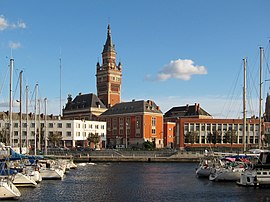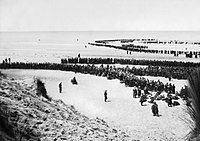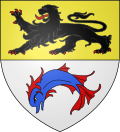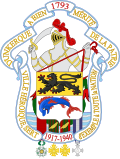Dunkirk
Dunkirk
| |
|---|---|
 Dunkirk Town Hall and port | |
| Coordinates:51°02′18″N2°22′39″E/ 51.0383°N 2.377500°E | |
| Country | France |
| Region | Hauts-de-France |
| Department | Nord |
| Arrondissement | Dunkerque |
| Canton | Dunkerque-1 Dunkerque-2 Grande-Synthe |
| Intercommunality | Dunkerque |
| Government | |
| • Mayor(2023–2026) | Jean Bodart[1] |
| Area 1 | 43.89 km2(16.95 sq mi) |
| Population (2021)[2] | 86,788 |
| • Density | 2,000/km2(5,100/sq mi) |
| Time zone | UTC+01:00(CET) |
| • Summer (DST) | UTC+02:00(CEST) |
| INSEE/Postal code | 59183/59140, 59240, 59640 |
| Elevation | 0–17 m (0–56 ft) (avg. 4 m or 13 ft) |
| 1French Land Register data, which excludes lakes, ponds, glaciers > 1 km2(0.386 sq mi or 247 acres) and river estuaries. | |
Dunkirk(UK:/dʌnˈkɜːrk/dun-KURK,US:/ˈdʌnkɜːrk/DUN-kurk,[3][4]French:Dunkerque[dœ̃kɛʁk],West Flemish:Duunkerke,Dutch:Duinkerke or Duinkerken) is acommunein thedepartmentofNordin northern France.[5]It lies 10 kilometres (6.2 mi) from theBelgianborder. It has the third-largest French harbour. The population of the commune in 2019 was 86,279.
Etymology and language use[edit]
The name of Dunkirk derives fromWest Flemishdun(e)'dune' or 'dun' andkerke'church', thus 'church in the dunes'.[6]A smaller town 25 km (15 miles) farther up the Flemish coast originally shared the same name, but was later renamedOostduinkerke(n) in order to avoid confusion.
Until the middle of the 20th century,French Flemish(the local variety ofDutch) was commonly spoken.
History[edit]
Middle Ages[edit]

Afishing villagearose late in the tenth century, in the originally flooded coastal area of theEnglish Channelsouth of theWestern Scheldt,when the area was held by theCounts of Flanders,vassals of theFrenchCrown. About AD 960, CountBaldwin IIIhad a town wall erected in order to protect the settlement againstVikingraids. The surrounding wetlands were drained and cultivated by the monks of nearbyBerguesAbbey. The nameDunkirkawas first mentioned in atitheprivilege of 27 May 1067, issued by CountBaldwin V of Flanders.[citation needed]CountPhilip I(1157–1191) brought further large tracts of marshland under cultivation, laid out the first plans to build aCanal from Dunkirk to Berguesand vested the Dunkirkers withmarket rights.
In the late 13th century, when theDampierrecountGuy of Flandersentered into theFranco-Flemish Waragainst his suzerain KingPhilippe IVofFrance,the citizens of Dunkirk sided with the French against their count, who at first was defeated at the 1297Battle of Furnes,but reachedde factoautonomy upon the victoriousBattle of the Golden Spursfive years later and exacted vengeance. Guy's son, CountRobert III(1305–1322), nevertheless granted further city rights to Dunkirk; his successor CountLouis I(1322–1346) had to face thePeasant revolt of 1323–1328,which was crushed by KingPhilippe VIof France at the 1328Battle of Cassel,whereafter the Dunkirkers again were affected by the repressive measures of the French king.
Count Louis remained a loyal vassal of the French king upon the outbreak of theHundred Years' WarwithEnglandin 1337, and prohibited the maritime trade, which led to another revolt by the Dunkirk citizens. After the count had been killed in the 1346Battle of Crécy,his son and successor CountLouis II of Flanders(1346–1384) signed a truce with the English; the trade again flourished and the port was significantly enlarged. However, in the course of theWestern Schismfrom 1378, English supporters ofPope Urban VI(the Roman claimant) disembarked at Dunkirk, captured the city and flooded the surrounding estates. They were ejected by KingCharles VI of France,but left great devastations in and around the town.
Upon the extinction of the Counts of Flanders with the death of Louis II in 1384, Flanders was acquired by theBurgundian,DukePhilip the Bold.The fortifications were again enlarged, including the construction of a belfrydaymark(a navigational aid similar to a non-illuminated lighthouse). As a strategic point, Dunkirk has always been exposed to political greed, by DukeRobert I of Barin 1395, byLouis de Luxembourgin 1435 and finally by theAustrianarchdukeMaximilian I of Habsburg,who in 1477 marriedMary of Burgundy,sole heiress of late DukeCharles the Bold.As Maximilian was the son of EmperorFrederick III,all Flanders was immediately seized by KingLouis XI of France.However, the archduke defeated the French troops in 1479 at theBattle of Guinegate.When Mary died in 1482, Maximilian retained Flanders according to the terms of the 1482Treaty of Arras.Dunkirk, along with the rest of Flanders, was incorporated into theHabsburg Netherlandsand upon the 1581 secession of theSeven United Netherlands,remained part of theSouthern Netherlands,which were held byHabsburg Spain(Spanish Netherlands) asImperialfiefs.

Corsair base[edit]
Burgundian Netherlands1384–1482
Habsburg Netherlands1482–1556
Spanish Netherlands1556–1577
Dunkirk Rebels1577–1583
Spanish Netherlands1583–1646
France1646–1652
Spanish Netherlands1652–1658
EnglandandFrance1658–1659
England1659–1662
France 1662–1870
Prussian occupation1870–1873
France1873–1940
German occupation1940–1945
France 1945–present

The area remained much disputed between theKingdom of Spain,theUnited Netherlands,theKingdom of Englandand theKingdom of France.At the beginning of theEighty Years' War,Dunkirk was briefly in the hands of the Dutch rebels, from 1577. Spanish forces under DukeAlexander FarneseofParmare-established Spanish rule in 1583 and it became a base for the notoriousDunkirkers.The Dunkirkers briefly lost their home port when the city was conquered by the French in 1646 but Spanish forces recaptured the city in 1652. In 1658, as a result of thelong warbetween France and Spain, it wascapturedafter a siege by Franco-English forces following thebattle of the Dunes.The city along withFort-Mardyckwas awarded to England inthe peace the following yearas agreed in the Franco-English alliance against Spain. The English governors wereSir William Lockhart(1658–60),Sir Edward Harley(1660–61) andLord Rutherford(1661–62).
On 17 October 1662, Dunkirk wassold to FrancebyCharles II of Englandfor £320,000.[7]The French government developed the town as a fortified port. The town's existing defences were adapted to create ten bastions. The port was expanded in the 1670s by the construction of a basin that could hold up to thirty warships with a double lock system to maintain water levels at low tide. The basin was linked to the sea by a channel dug through coastal sandbanks secured by two jetties. This work was completed by 1678. The jetties were defended a few years later by the construction of five forts, Château d'Espérance, Château Vert, Grand Risban, Château Gaillard, and Fort de Revers. An additional fort was built in 1701 called Fort Blanc.
During the reign ofLouis XIV,a large number ofcommerce raidersandpiratesonce again made their base at Dunkirk, the most famous of whom wasJean Bart.The main character (and possible real prisoner) in the famous novelMan in the Iron MaskbyAlexandre Dumaswas arrested at Dunkirk. The eighteenth-century Swedish privateers and piratesLars Gathenhielmand his wifeIngela Hammarare known to have sold their gains in Dunkirk.
As France and Great Britain became commercial and military rivals, the British grew concerned about Dunkirk being used as an invasion base to cross the English Channel. The jetties, their forts, and the port facilities were demolished in 1713 under the terms of theTreaty of Utrecht.[8]TheTreaty of Parisof 1763, which concluded theSeven Years' War,included a clause restricting French rights to fortify Dunkirk. This clause was overturned in the subsequentTreaty of Versaillesof 1783.[9]
Dunkirk in World War I[edit]
Dunkirk's port was used extensively during the war by British forces who brought in dock workers from, among other places, Egypt and China.[10]
From 1915, the city experienced severe bombardment, including from the largest gun in the world in 1917, the German 'Lange Max'. On a regular basis, heavy shells weighing approximately 750 kg (1700 lb) were fired fromKoekelare,about 45–50 km (30 miles) away.[11]The bombardment killed nearly 600 people and wounded another 1,100, both civilian and military, while 400 buildings were destroyed and 2,400 damaged. The city's population, which had been 39,000 in 1914, reduced to fewer than 15,000 in July 1916 and 7,000 in the autumn of 1917.[10]
In January 1916, a spy scare took place in Dunkirk. The writerRobert W. Service,then a war correspondent for theToronto Star,was mistakenly arrested as a spy and narrowly avoided being executed out of hand.[12]On 1 January 1918, theUnited States Navyestablished anaval air stationto operateseaplanes.The base closed shortly after theArmistice of 11 November 1918.[13]
In October 1917, to mark the gallant behaviour of its inhabitants during the war, the City of Dunkirk was awarded theCroix de Guerreand, in 1919, theLegion of Honourand the BritishDistinguished Service Cross.[10][14]These decorations now appear in the city's coat of arms.[15]
Dunkirk in World War II[edit]
Evacuation[edit]

During theSecond World War1940Battle of France,theBritish Expeditionary Force(BEF), while aiding the French and Belgian armies, were forced to retreat in the face of overpowering German Panzer attacks. Fighting in Belgium and France, the BEF and a portion of the French Army became outflanked by the Germans and retreated to the area around the port of Dunkirk. More than 400,000 soldiers were trapped in the pocket as the German Army closed in for the kill. Unexpectedly, the German Panzer attack halted for several days at a critical juncture. For years, it was assumed thatAdolf Hitlerordered the German Army to suspend the attack, favouring bombardment by theLuftwaffe.However, according to the Official War Diary ofArmy Group A,its commander,GeneraloberstGerd von Rundstedt,ordered the halt to allow maintenance on his tanks, half of which were out of service, and to protect his flanks which were exposed and, he thought, vulnerable.[16]Hitler merely validated the order several hours later.[17]This lull gave the British and French a few days to fortify their defences. The Allied position was complicated by Belgian KingLeopold III's surrender on 27 May, which was postponed until 28 May. The gap left by the Belgian Army stretched from Ypres to Dixmude. Nevertheless,a collapse was prevented,making it possible to launch anevacuation by sea,across theEnglish Channel,codenamed Operation Dynamo.British Prime MinisterWinston Churchillordered any ship or boat available, large or small, to collect the stranded soldiers. 338,226 men (including 123,000 French soldiers) were evacuated – themiracle of Dunkirk,as Churchill called it. It took over 900 vessels to evacuate the BEF, with two-thirds of those rescued embarking via the harbour, and over 100,000 taken off the beaches. More than 40,000 vehicles as well as massive amounts of other military equipment and supplies were left behind. Forty thousand Allied soldiers (some who carried on fighting after the official evacuation) were captured or forced to make their own way home through a variety of routes including via neutral Spain. Many wounded who were unable to walk were abandoned.
Liberation[edit]

Dunkirk was again contested in 1944, with the2nd Canadian Infantry Divisionattempting to liberate the city in September, as Allied forces surged northeast after their victory in theBattle of Normandy.However, German forces refused to relinquish their control of the city, which had been converted into a fortress. To seize the now strategically insignificant town would consume too many Allied resources which were needed elsewhere. The town was by-passed masking the German garrison with Allied troops, notably the1st Czechoslovak Armoured Brigade.During theGerman occupation,Dunkirk was largely destroyed by Allied bombing. The artillery siege of Dunkirk was directed on the final day of the war by pilots fromNo. 652 Squadron RAF,andNo. 665 Squadron RCAF.[citation needed]The fortress, under the command of German AdmiralFriedrich Frisius,eventually unconditionally surrendered to the commander of the Czechoslovak forces,Brigade GeneralAlois Liška,on 9 May 1945.[18]
Postwar Dunkirk[edit]
This sectionneeds expansion.You can help byadding to it.(August 2013) |
On 14 December 2002, the Norwegiancar carrierMVTricolorcollided with theBahamian-registeredKaribaand sank off Dunkirk Harbour, causing a hazard to navigation in theEnglish Channel.[19]
Population[edit]
The population data in the table and graph below refer to the commune of Dunkirk proper, in its geography at the given years. The commune of Dunkirk absorbed the former commune of Malo-les-Bains in 1969,RosendaëlandPetite-Synthein 1971,Mardyckin 1979 andFort-MardyckandSaint-Pol-sur-Merin 2010.[5][20]
|
| ||||||||||||||||||||||||||||||||||||||||||||||||||||||||||||||||||||||||||||||||||||||||||||||||||||||||||||||||||
| |||||||||||||||||||||||||||||||||||||||||||||||||||||||||||||||||||||||||||||||||||||||||||||||||||||||||||||||||||
| Source: EHESS[20]and INSEE (1968-2017)[21][22] | |||||||||||||||||||||||||||||||||||||||||||||||||||||||||||||||||||||||||||||||||||||||||||||||||||||||||||||||||||
Politics[edit]
Dunkirk is part ofNord's 13th constituency,The currentMember of ParliamentisChristine Decodtsof themiscellaneous centre.
Presidential elections second round[edit]
| Election | Candidate | Party | % | |
|---|---|---|---|---|
| 2022[23] | Emmanuel Macron | En Marche! | 51.35 | |
| 2017[23] | Emmanuel Macron | En Marche! | 54.42 | |
| 2012 | François Hollande | PS | 55.37 | |
| 2007 | Nicolas Sarkozy | UMP | 52.30 | |
| 2002 | Jacques Chirac | RPR | 79.16 | |
Heraldry[edit]
 |
The arms of Dunkirk areblazoned: Per fess Or and argent, a lion passant sable armed and langued gules, and a dolphin naiant azure crested, barbed, finned and tailed gules. At their base, the arms display the insignia of the four medals awarded to the city: theLegion of Honour,Croix de Guerreand BritishDistinguished Service Crossfor World War I; and a second Croix de Guerre for World War II.[15] The city also has its own flag, made up of six horizontal stripes of alternate white and azure blue.[15] |

|
Administration[edit]

The commune has grown substantially by absorbing several neighbouring communes:
- 1970: Merger with Malo-les-Bains (which had been created by being detached from Dunkirk in 1881)
- 1972: Fusion withPetite-Syntheand Rosendaël (the latter had been created by being detached fromTéteghemin 1856)
- 1980: Fusion-association with Mardyck (which became anassociated commune,with a population of 372 in 1999)
- 1980: A large part of Petite-Synthe is detached from Dunkirk and included intoGrande-Synthe
- 2010: After a failed fusion-association attempt withSaint-Pol-sur-MerandFort-Mardyckin 2003, both successfully become associated communes with Dunkirk in December 2010.
Economy[edit]
Dunkirk has the third-largest harbour in France, after those ofLe HavreandMarseille.[24]As an industrial city, it depends heavily on thesteel,food processing,oil-refining,ship-buildingandchemicalindustries.
Cuisine[edit]
The cuisine of Dunkirk closely resembles Flemishcuisine;perhaps one of the best known dishes iscoq à la bière– chicken in a creamy beer sauce.
Prototype metre[edit]

In June 1792 the French astronomersJean Baptiste Joseph DelambreandPierre François André Méchainset out to measure themeridian arcdistance from Dunkirk toBarcelona,two cities lying on approximately the samelongitudeas each other and also the longitude through Paris. The belfry was chosen as the reference point in Dunkirk.
Using this measurement and thelatitudesof the two cities they could calculate the distance between theNorth Poleand theEquatorin classical French units of length and hence produce the first prototypemetrewhich was defined as being one ten millionth of that distance.[25]The definitive metre bar, manufactured from platinum, was presented to the French legislative assembly on 22 June 1799.
Dunkirk was the most easterly cross-channel measuring point for theAnglo-French Survey (1784–1790),which usedtriangulationto calculate the precise distance between theParis Observatoryand theRoyal Greenwich Observatory.Sightings were made of signal lights atDover Castlefrom the Dunkirk Belfry, and vice versa.
Tourist attractions[edit]
Two belfries in Dunkirk (the belfry near theChurch of Saint-Éloiand the one at the town hall) are part of a group ofbelfries of Belgium and France,inscribed on the UNESCO World Heritage List in 2005 in recognition of their civic architecture and importance in the rise of municipal power in Europe.[26]
The 63-meter-high Dunkirk Lighthouse, also known as the Risban Light, was built between 1838 and 1843 as part of early efforts to place lights around the coast of France. At the time of its construction it was one of only two first order lighthouses (the other being Calais) to be set up in a port. Automated since 1985, the light can be seen 28 nautical miles (48 km) away. In 2010 it was listed as an historical monument.
Two museums in Dunkirk include:
- TheMusée Portuaire,which displays exhibits of images about the history and presence of the port.
- TheMusée des Beaux-Arts,which has a large collection of Flemish, Italian and French paintings and sculptures.
-
The Tour du Leughenaer (Tour du Leughenaer[fr]) (the Liar's Tower)
-
Dunkirk Town Hall
-
Carnival in Dunkirk
-
Malo-les-Bains beach front
-
Dunkirk Beach
-
The remains of the East Mole of Dunkirk harbour, pictured in 2009
-
Léon Germain Pelouse,La Vallée de Cernay,1873, Musée des Beaux-Arts
Transport[edit]
Dunkirk has a ferry route toDoverthat is run byDFDS,which serves as an alternative to the route to the service to nearbyCalais.The Dover-Dunkirk ferry route takes two hours compared to Dover-Calais' 1 hour 30 minutes, is run bythreevessels and runs every two hours from Dunkirk. Another DFDS route connects Dunkirk toRosslare Europortin theRepublic of Irelandand carries truck freight as well as a limited number of private car passengers. The Dunkirk-Rosslare route take 24 hours and is run by the MFRegina Seaways.
TheGare de Dunkerquerailway station offers connections toGare de Calais-Ville,Gare de Lille Flandres,Arras and Paris, and several regional destinations in France. The railway line from Dunkirk toDe PanneandAdinkerke,Belgium, is closed and has been dismantled in places.
In September 2018, Dunkirk's public transit service introduced free public transport, thereby becoming the largest city in Europe to do so. Several weeks after the scheme had been introduced, the city's mayor, Patrice Vergriete, reported that there had been 50% increase in passenger numbers on some routes, and up to 85% on others. As part of the transition towards offering free bus services, the city's fleet was expanded from 100 to 140 buses, including new vehicles which run on natural gas.[27]As of August 2019, approximately 5% of 2000 people surveyed had used the free bus service to completely replace their cars.[28]
Sports[edit]
- USL Dunkerque,Frenchfootballclub, currently playing inLigue 2.
- TheFour Days of Dunkirk(orQuatre Jours de Dunkerque) is an important elite professionalroad bicycle racingevent.
- Stage 2 of the2007 Tour de Francedeparted from Dunkirk.
Notable residents[edit]

- Jean Bart(1650—1702), naval commander and privateer
- Eugène Chigot,19th-century post impressionist painter
- Marvin Gakpa(born 1993), footballer
- Louise Lavoye(1823—1897), 19th-century soprano
- Robert Malm(born 1973), footballer
- Jean-Paul Rouve(born 1967), actor
- François Rozenthal(born 1975), ice hockey player
- Maurice Rozenthal(born 1975), ice hockey player
- Djoumin Sangaré(born 1983), footballer
- Tancrède Vallerey(born 1892, date of death unknown), writer
International relations[edit]
Twin towns – sister cities[edit]
 Krefeld,North Rhine-Westphalia, Germany since 15 June 1974
Krefeld,North Rhine-Westphalia, Germany since 15 June 1974 Middlesbrough,England, United Kingdom since 12 April 1976
Middlesbrough,England, United Kingdom since 12 April 1976 Gaza,Palestine since 2 April 1996
Gaza,Palestine since 2 April 1996 Rostock,Mecklenburg-Vorpommern, Germany since 9 April 2000
Rostock,Mecklenburg-Vorpommern, Germany since 9 April 2000 Ramat HaSharon,Israel since 15 September 1997
Ramat HaSharon,Israel since 15 September 1997 Qinhuangdao,Hebei,China since 25–26 September 2000
Qinhuangdao,Hebei,China since 25–26 September 2000
Friendship links[edit]
Dunkirk has co-operation agreements with:
- Dartford,Kent,England, United Kingdom since March 1988[30]
- Thanet,Kent, England, United Kingdom since 18 June 1993[30]
Climate[edit]
Dunkirk has anoceanic climate,with cool winters and warm summers. According to theKöppen Climate Classificationsystem, Dunkirk has amarine west coast climate,abbreviated "Cfb" on climate maps.[31]Summer high temperatures average around 20 to 21 °C (68 to 70 °F), being significantly influenced by the marine currents.
| Climate data for Dunkirk (1991–2020 averages, records 1892–present) | |||||||||||||
|---|---|---|---|---|---|---|---|---|---|---|---|---|---|
| Month | Jan | Feb | Mar | Apr | May | Jun | Jul | Aug | Sep | Oct | Nov | Dec | Year |
| Record high °C (°F) | 16.4 (61.5) |
19.1 (66.4) |
24.0 (75.2) |
28.4 (83.1) |
34.0 (93.2) |
34.4 (93.9) |
41.3 (106.3) |
36.2 (97.2) |
35.2 (95.4) |
30.0 (86.0) |
20.1 (68.2) |
16.6 (61.9) |
41.3 (106.3) |
| Mean daily maximum °C (°F) | 7.6 (45.7) |
8.0 (46.4) |
10.2 (50.4) |
13.1 (55.6) |
16.0 (60.8) |
18.9 (66.0) |
21.2 (70.2) |
21.7 (71.1) |
19.3 (66.7) |
15.6 (60.1) |
11.1 (52.0) |
8.3 (46.9) |
14.3 (57.7) |
| Daily mean °C (°F) | 5.5 (41.9) |
5.7 (42.3) |
7.7 (45.9) |
10.2 (50.4) |
13.3 (55.9) |
16.1 (61.0) |
18.4 (65.1) |
18.8 (65.8) |
16.5 (61.7) |
13.0 (55.4) |
9.0 (48.2) |
6.2 (43.2) |
11.7 (53.1) |
| Mean daily minimum °C (°F) | 3.4 (38.1) |
3.5 (38.3) |
5.3 (41.5) |
7.4 (45.3) |
10.5 (50.9) |
13.3 (55.9) |
15.5 (59.9) |
15.8 (60.4) |
13.6 (56.5) |
10.4 (50.7) |
6.9 (44.4) |
4.2 (39.6) |
9.2 (48.6) |
| Record low °C (°F) | −13.4 (7.9) |
−18.0 (−0.4) |
−7.0 (19.4) |
−2.0 (28.4) |
−1.0 (30.2) |
4.0 (39.2) |
6.6 (43.9) |
4.0 (39.2) |
4.0 (39.2) |
−2.4 (27.7) |
−8.0 (17.6) |
−10.6 (12.9) |
−18.0 (−0.4) |
| Averageprecipitationmm (inches) | 53.9 (2.12) |
45.4 (1.79) |
41.9 (1.65) |
36.7 (1.44) |
45.5 (1.79) |
54.5 (2.15) |
58.5 (2.30) |
64.2 (2.53) |
64.9 (2.56) |
73.0 (2.87) |
79.5 (3.13) |
72.8 (2.87) |
690.8 (27.20) |
| Average precipitation days(≥ 1.0 mm) | 11.4 | 9.9 | 9.2 | 7.9 | 8.6 | 8.8 | 8.5 | 9.4 | 9.9 | 11.9 | 13.1 | 12.8 | 121.3 |
| Average snowy days | 2.9 | 2.7 | 1.8 | 0.8 | 0.1 | 0.0 | 0.0 | 0.0 | 0.0 | 0.0 | 0.8 | 1.9 | 11.0 |
| Averagerelative humidity(%) | 86 | 84 | 81 | 80 | 79 | 80 | 80 | 80 | 81 | 83 | 84 | 85 | 81.8 |
| Source 1:Météo France,[32]Infoclimat.fr (humidity and snowy days, 1961–1990)[33] | |||||||||||||
| Source 2:[34][35] | |||||||||||||
See also[edit]
- Allied advance from Paris to the Rhine
- Dunkirkers
- French Flanders
- French Flemish
- Hortense Clémentine Tanvet
- Liberation of France
- Treaty of Dunkirk
- Flanders bank
References[edit]
- ^"Répertoire national des élus: les maires"(in French). data.gouv.fr, Plateforme ouverte des données publiques françaises. 30 November 2023.
- ^"Populations légales 2021"(in French).The National Institute of Statistics and Economic Studies.28 December 2023.
- ^Wells, John C.(2008).Longman Pronunciation Dictionary(3rd ed.). Longman.ISBN978-1-4058-8118-0.
- ^Jones, Daniel(2011).Roach, Peter;Setter, Jane;Esling, John(eds.).Cambridge English Pronouncing Dictionary(18th ed.). Cambridge University Press.ISBN978-0-521-15255-6.
- ^abCommune de Dunkerque (59183),INSEE
- ^Pul, Paul Van (2007).In Flanders Flooded Fields: Before Ypres There Was Yser.Pen and Sword. p. 89.ISBN978-1-4738-1431-8.
The French name ofDunkerquein fact is derived from the FlemishDuinkerke,which means 'church in the dunes'!
- ^"Correspondence and papers of the first Duke of Ormonde, chiefly on Irish and English public affairs: ref. MS. Carte 218, fol(s). 5 – date: 26 December 1662"(Description of contents of carte papers).Oxford University, Bodleian Library, Special Collections and Western Manuscripts: Carte Papers. 2006.Retrieved17 October2007.[permanent dead link]
- ^"Dunkirk".Fortified Places.Archived fromthe originalon 15 June 2013.Retrieved26 March2013.
- ^Ward, Sir Adolphus William (1922)."1783–1815".
- ^abc"La Grande Guerre (fr)".Dunkerque & vous.Retrieved9 November2018.
- ^"Lange Max Museum".Lange Max Museum.27 October 2023.
- ^"Robert Service biography".robertwservice.Archived fromthe originalon 12 May 2021.Retrieved9 November2018.
- ^Van Wyen, Adrian O. (1969).Naval Aviation in World War I.Washington, D.C.: Chief of Naval Operations. p.60.
- ^"Traces of War".TracesOfWar.Retrieved8 November2018.
- ^abc"Les Armoiries de la Ville (fr)".Dunkerque & vous.Retrieved9 November2018.
- ^Levine, Joshua (2017) Dunkirk, Harper Collins, New York
- ^Lord, Walter (1982). "2: No. 17 Turns Up".The Miracle of Dunkirk.New York City: Open Road Integrated Media, Inc. pp. 28–35.ISBN978-1-5040-4754-8.
- ^"Vzpomínky na obléhání pevnosti"(PDF).Reportáž.Archived fromthe original(PDF)on 2 December 2007.
- ^"The Tricolor/Kariba/Clary Incident".21 March 2008.
- ^abDes villages de Cassini aux communes d'aujourd'hui:Commune data sheet Dunkerque,EHESS(in French).
- ^Population en historique depuis 1968,INSEE
- ^Populations légales en vigueur à compter du 1er janvier 2010: 59 - Nord,INSEE
- ^ab"Résultats élections Dunkerque (59140)".Le Monde.
- ^http:// worldshipping.org/about-the-industry/global-trade/portsArchived2020-05-03 at theWayback MachineWorld Port Rankings 2015
- ^Adler, Ken (2002).The measure of all things: The seven year odyssey that transformed the world.Abacus.ISBN978-0-349-11507-8.
- ^"Belfries of Belgium and France".UNESCO World Heritage Centre.United Nations Educational, Scientific, and Cultural Organization.Retrieved5 November2021.
- ^Willsher, Kim (15 October 2018)."'I leave the car at home': how free buses are revolutionising one French city ".The Guardian.Retrieved15 October2018.
- ^"French city of Dunkirk tests out free transport – and it works".France24.31 August 2019.Retrieved17 September2019.
- ^"Jumelage".ville-dunkerque.fr(in French). Dunkirk.Retrieved12 November2019.
- ^ab"Dunkirk International"(in French). Archived fromthe originalon 9 November 2007.Retrieved17 December2007.
- ^"Dunkerque, France Köppen Climate Classification (Weatherbase)".Weatherbase.Retrieved6 September2015.
- ^"Dunkerque (59)"(PDF).Fiche Climatologique: Statistiques 1981–2010 et records(in French).Météo-France.Archived fromthe original(PDF)on 10 March 2018.Retrieved7 September2022.
- ^"Normes et records 1961–1990: Dunkerque (59) – altitude 11m"(in French). Infoclimat. Archived fromthe originalon 3 March 2016.Retrieved10 March2018.
- ^"Meteo 59–62".Archived fromthe originalon 18 October 2013.Retrieved18 April2013.
- ^"Canicule: la France a connu hier une chaleur record au niveau national".meteofrance.fr(in French).Météo-France.Archived fromthe originalon 31 July 2019.Retrieved26 July2019.
External links[edit]
- City council website(in French)
- Tourist office website
- Dunkirk
- Communes of Nord (French department)
- France–United Kingdom border crossings
- Port cities and towns on the French Atlantic coast
- Port cities and towns of the North Sea
- Subprefectures in France
- Recipients of the Distinguished Service Cross (United Kingdom)
- Juxtaposed border controls
- Pirate dens and locations
- Vauban fortifications in France
- French Flanders






![The Tour du Leughenaer (Tour du Leughenaer [fr]) (the Liar's Tower)](https://upload.wikimedia.org/wikipedia/commons/thumb/a/a0/Dunkerque_Tour_du_Leughenaer.jpg/62px-Dunkerque_Tour_du_Leughenaer.jpg)





